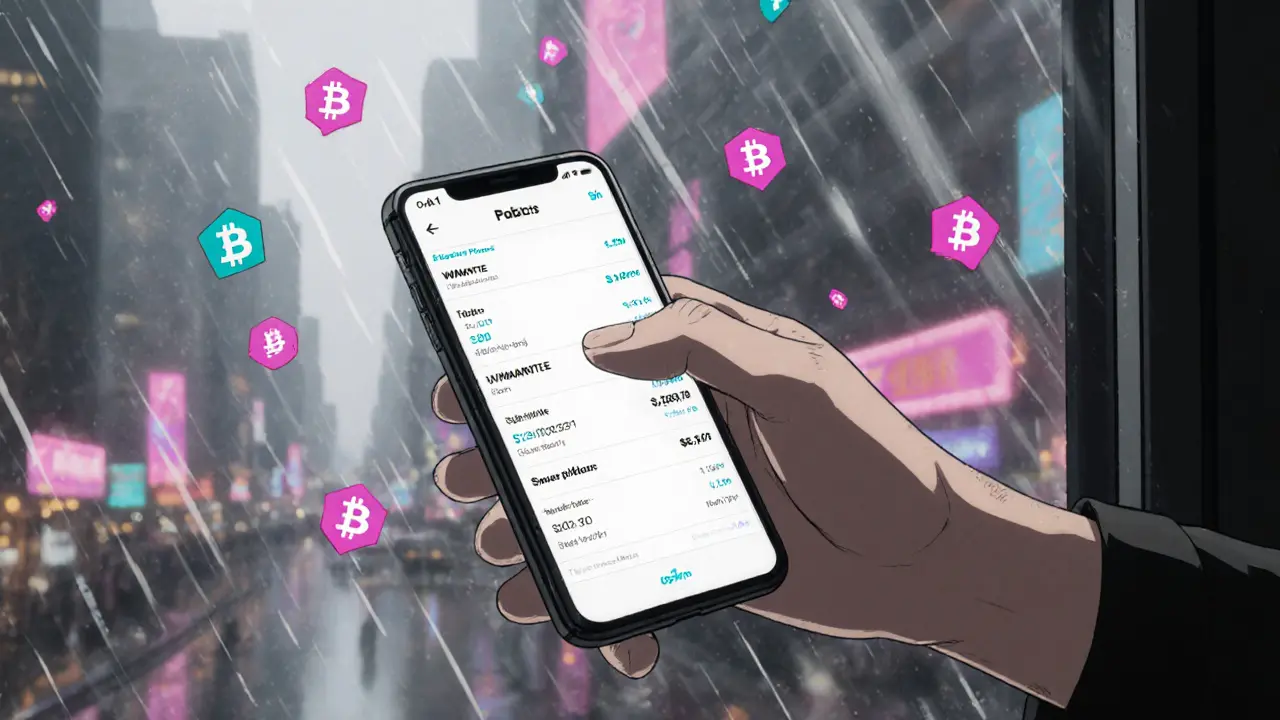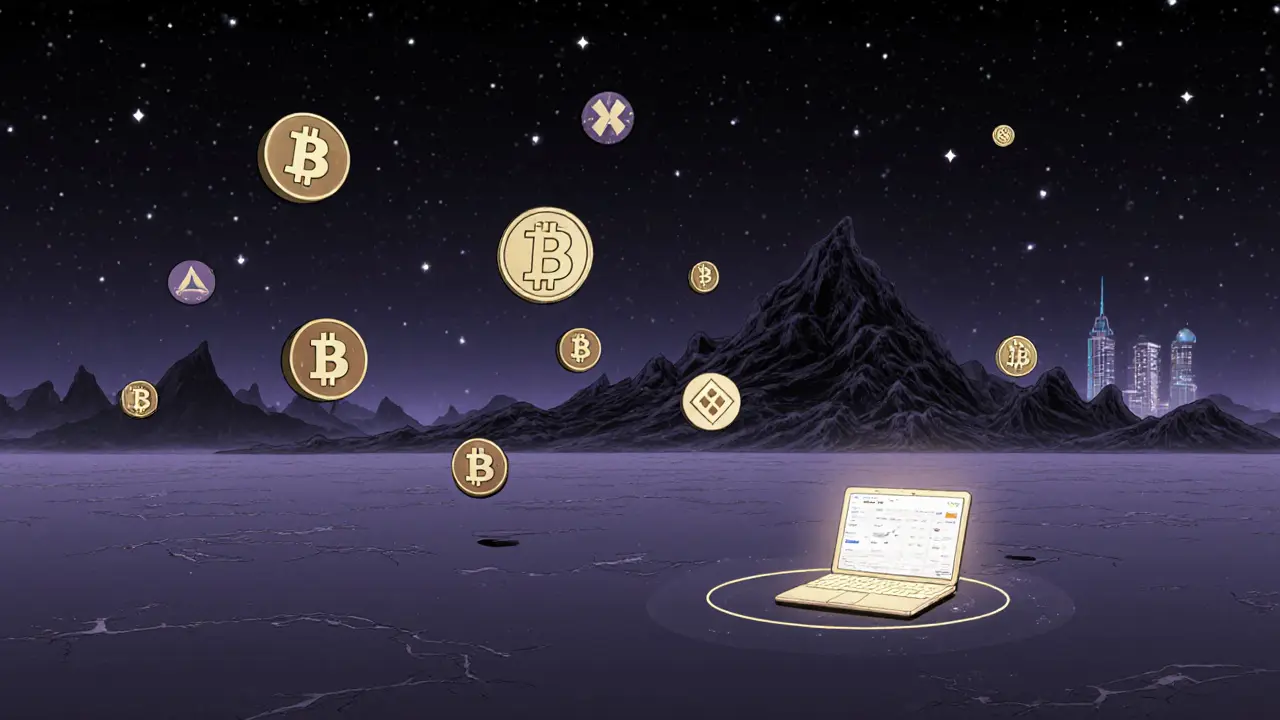Fee Savings Calculator
How Much Can You Save?
Compare your annual trading fees on traditional exchanges versus Merchant Moe's zero-fee model.
Your Annual Savings
Based on $0 monthly volume and 0 trades/day
Important: This calculation shows potential savings from fee structure only. Does not account for liquidity limitations, token availability, or network fees on Mantle.
Most crypto exchanges charge you every time you trade. Even the big ones like Binance or Coinbase take 0.1% to 0.2% per trade. That adds up fast if you’re swapping tokens daily. But what if you could trade for free? That’s the promise of Merchant Moe, a decentralized exchange built on the Mantle Network. No maker fees. No taker fees. Just pure, uncut trading. But is it too good to be true? Let’s break it down - what works, what doesn’t, and who it’s actually for.
What Is Merchant Moe?
Merchant Moe is a decentralized crypto exchange launched in 2024. It doesn’t hold your money. It doesn’t act as a middleman. Instead, it runs on smart contracts on the Mantle Network - an Ethereum Layer-2 blockchain designed to be faster and cheaper than the main Ethereum chain. When you trade on Merchant Moe, you’re interacting directly with code, not a company. Your wallet connects, you pick a pair, and the trade executes automatically.
It’s not a new idea. Uniswap and PancakeSwap did this first. But Merchant Moe’s twist? Zero fees. While Uniswap charges 0.3% and PancakeSwap takes 0.25%, Merchant Moe charges nothing. That’s rare. And it’s not marketing fluff - it’s baked into the platform’s design. This makes it attractive for high-frequency traders, arbitrageurs, or anyone tired of paying fees just to move between tokens.
What You Can Trade
Don’t expect thousands of tokens. As of late 2025, Merchant Moe supports only 9 coins and 16 trading pairs. The most active pair is WETH/USDT, which saw a 5.11% daily spike in one recent report. Other tokens include WMANTLE, USDT, USDC, and a few native Mantle ecosystem tokens. If you’re looking to trade Solana-based coins or Bitcoin on Layer-2, you won’t find them here.
This narrow focus isn’t a bug - it’s a strategy. Merchant Moe isn’t trying to beat Uniswap. It’s trying to be the go-to DEX for the Mantle ecosystem. If you’re already using Mantle for staking, lending, or gaming, Merchant Moe is the natural place to swap tokens without paying gas fees on Ethereum. But if you’re new to crypto or want broad access to altcoins, this isn’t your exchange.
How It Works: Wallets, Liquidity, and Trading
To use Merchant Moe, you need a wallet. MetaMask is the most common choice. You connect it, pick a token pair, and swap. No sign-up. No KYC. No email. That’s the DeFi way. But here’s the catch: you need to understand slippage, gas fees on Mantle, and how liquidity pools work. There’s no guided onboarding. No tutorial videos on their site. If you’ve never used a DEX before, you’ll be lost.
Trading options are limited to spot trading. No margin, no leverage - at least not on the native platform. Some sources mention futures trading, but those appear to be third-party integrations or confusion with centralized exchanges. The platform also has a Launchpad for new token sales and an OTC desk for large trades, but these features are barely visible on the website. You’ll need to dig for them.
Mobile and Desktop Apps
Merchant Moe offers both a desktop web app and a mobile app. The interface is clean, minimal, and fast. It loads quickly because it runs on Mantle’s low-latency chain. But the apps don’t offer anything extra beyond the web version. No price alerts. No portfolio tracking. No news feed. It’s a pure trading terminal. If you want advanced tools, you’ll need to use external dashboards like DeFiLlama or CoinGecko.
The mobile app is especially barebones. No fingerprint login. No biometrics. No push notifications. It’s functional, but not polished. Compare that to Trust Wallet or MetaMask’s built-in DEX browser - they’re more user-friendly, even if they charge fees.

Where You Can Buy MOE Tokens
Merchant Moe’s native token, MOE, isn’t listed on major exchanges like Binance or Coinbase. You can’t buy it with a credit card on the platform itself. But here’s the workaround: Atomic Wallet lets you buy MOE with a credit card, starting at $50 and going up to $20,000 per day. That’s a big deal for beginners who don’t want to go through the hassle of buying ETH, bridging to Mantle, and swapping for MOE.
Users on Atomic Wallet say things like, “Best wallet out there! Swap feature is great and cheap.” But those reviews are about Atomic Wallet - not Merchant Moe. There’s almost no direct feedback on Merchant Moe’s own platform. No Reddit threads. No Twitter buzz. No YouTube tutorials. That’s a red flag. If no one’s talking about it, why is it still alive?
Traffic and Adoption: A Niche Player
Merchant Moe gets between 4,000 and 4,500 monthly visits. That’s tiny. Coinbase gets over 100 million. Uniswap gets tens of millions. Merchant Moe ranks 398 out of 589 crypto exchanges in traffic. It’s not even in the top 100 DEXs.
Organic traffic makes up 99% of its visits - meaning people are finding it by searching “Merchant Moe” directly. No referral traffic. No social media growth. No PR. No partnerships beyond its core Mantle integration. The bounce rate is high - 42% to 56%. Visitors stay for about 2 minutes and view 2.35 pages. That suggests curiosity, not loyalty. People land, check it out, and leave.
Compare that to Uniswap, which processed $320 billion in volume in 2023. Merchant Moe’s volume? Probably under $10 million. It’s not a threat to the giants. It’s a small pond for a specific kind of fish.
Regulation and Security
Merchant Moe is not regulated. Not by the SEC. Not by the FCA. Not by any government body. FxVerify explicitly states: “This company does not appear to be regulated by any government authority at this time.” That’s normal for DeFi - but it’s still risky. If the smart contracts get hacked, there’s no customer support. No insurance. No refunds.
The platform has no public audit reports. No bug bounty program. No known security team. That’s a problem. In crypto, trust isn’t built on promises - it’s built on transparency. No audits? No team bios? No history? That’s not a dealbreaker for everyone, but it should raise eyebrows.

Who Is This For?
Merchant Moe isn’t for everyone. It’s not for beginners. It’s not for people who want to trade 500 different tokens. It’s not for those who need customer service.
It is for:
- Traders already active on the Mantle Network
- People who hate paying trading fees and want to minimize costs
- Developers or power users comfortable with wallet connections and smart contracts
- Those betting on Mantle’s growth and want to be early in its native DEX
If you’re holding WMANTLE or using Mantle-based DeFi apps, Merchant Moe makes sense. It’s the cheapest way to swap within that ecosystem. But if you’re just exploring crypto, stick with Coinbase or Kraken. They’re easier, safer, and have way more options.
The Big Question: Is It Worth It?
Zero fees are powerful. In a world where every trade costs money, a free exchange stands out. But free doesn’t mean better. Merchant Moe’s lack of liquidity, limited tokens, no regulatory oversight, and tiny user base make it a high-risk, high-reward play.
Its future depends entirely on Mantle. If Mantle grows - if it gets more dApps, more users, more institutional interest - then Merchant Moe could become the default swap tool for that ecosystem. But if Mantle stalls, Merchant Moe fades into obscurity.
Right now, it’s a tool for a niche. Not a revolution. Not a replacement for Uniswap. Just a quiet, fee-free corner of the DeFi world - useful if you’re already there, useless if you’re not.
Final Verdict
Merchant Moe delivers on its promise: zero trading fees. It’s fast. It’s simple. It’s built on a promising Layer-2 chain. But it’s also small, unregulated, and under-the-radar. There’s no community. No support. No safety net.
Use it if you’re deep in the Mantle ecosystem and want to save on fees. Avoid it if you’re new, want broad token access, or need peace of mind. It’s not the next big thing. But for a very specific group of users, it’s the best option they’ve got.
Is Merchant Moe safe to use?
Merchant Moe is as safe as the smart contracts it runs on. Since it’s decentralized and unregulated, there’s no company to hold accountable if something goes wrong. No audits have been publicly released, and there’s no insurance or customer support. If you lose funds due to a bug or hack, you’re out of luck. Only use it with money you’re willing to lose.
Can I buy crypto with a credit card on Merchant Moe?
No, you cannot buy crypto directly with a credit card on Merchant Moe’s platform. However, you can buy its native MOE token using a credit card through Atomic Wallet, which supports purchases from $50 up to $20,000 per day. You’ll need to buy MOE there, then transfer it to your wallet to trade on Merchant Moe.
Does Merchant Moe support margin or leverage trading?
Merchant Moe’s native platform only supports spot trading. Some sources mention futures trading, but those appear to refer to third-party integrations or confusion with centralized exchanges. There is no built-in margin or leverage functionality on the official Merchant Moe interface.
How does Merchant Moe compare to Uniswap?
Merchant Moe charges 0% fees, while Uniswap charges 0.3%. But Uniswap supports over 1,500 tokens across multiple blockchains and has billions in daily volume. Merchant Moe supports only 9 tokens, all on the Mantle Network, with minimal volume. Uniswap is the industry standard. Merchant Moe is a niche alternative for Mantle users who want to avoid fees.
What wallets work with Merchant Moe?
MetaMask is the most commonly used wallet. Any wallet that supports the Mantle Network and EVM-compatible chains will work. This includes WalletConnect-compatible wallets like Rainbow, Argent, and Rabby. You must connect your wallet manually - there’s no built-in wallet on the platform.
Is Merchant Moe a good investment because of its zero fees?
No. The zero-fee structure doesn’t make MOE a good investment. Token value depends on adoption, utility, and demand. Merchant Moe has low traffic, no major partnerships, and no clear revenue model. MOE’s value is tied to the success of the Mantle Network - not the exchange itself. Don’t buy MOE expecting price growth just because fees are zero.
Can I use Merchant Moe on my phone?
Yes, there is a mobile app for Android and iOS. But it’s basic. It doesn’t offer alerts, portfolio tracking, or advanced features. It’s just a mobile version of the web interface. You still need to connect your wallet. For most users, using the web version through a mobile browser with MetaMask is just as easy.
What’s the difference between Merchant Moe and a centralized exchange like Binance?
Centralized exchanges like Binance hold your crypto, require KYC, offer customer support, and charge fees. Merchant Moe doesn’t hold your funds, requires no ID, charges no fees, and has no support team. With Binance, you trade through a company. With Merchant Moe, you trade through code. That’s the core difference: control vs. convenience.

Debby Ananda
October 31, 2025 AT 09:18Vicki Fletcher
November 1, 2025 AT 18:26Nadiya Edwards
November 2, 2025 AT 22:15Ron Cassel
November 2, 2025 AT 23:13Malinda Black
November 3, 2025 AT 11:32Chris Strife
November 3, 2025 AT 16:07Mehak Sharma
November 4, 2025 AT 00:38Kymberley Sant
November 4, 2025 AT 03:18Edgerton Trowbridge
November 6, 2025 AT 01:15Matthew Affrunti
November 6, 2025 AT 19:44mark Hayes
November 8, 2025 AT 05:59David Roberts
November 9, 2025 AT 08:19Monty Tran
November 10, 2025 AT 04:35Beth Devine
November 11, 2025 AT 20:28Brian McElfresh
November 13, 2025 AT 18:35Hanna Kruizinga
November 14, 2025 AT 09:10David James
November 15, 2025 AT 11:16Shaunn Graves
November 17, 2025 AT 00:19Jessica Hulst
November 17, 2025 AT 03:55Kaela Coren
November 17, 2025 AT 18:25Nabil ben Salah Nasri
November 19, 2025 AT 14:58alvin Bachtiar
November 20, 2025 AT 06:52Josh Serum
November 21, 2025 AT 14:57DeeDee Kallam
November 23, 2025 AT 02:00